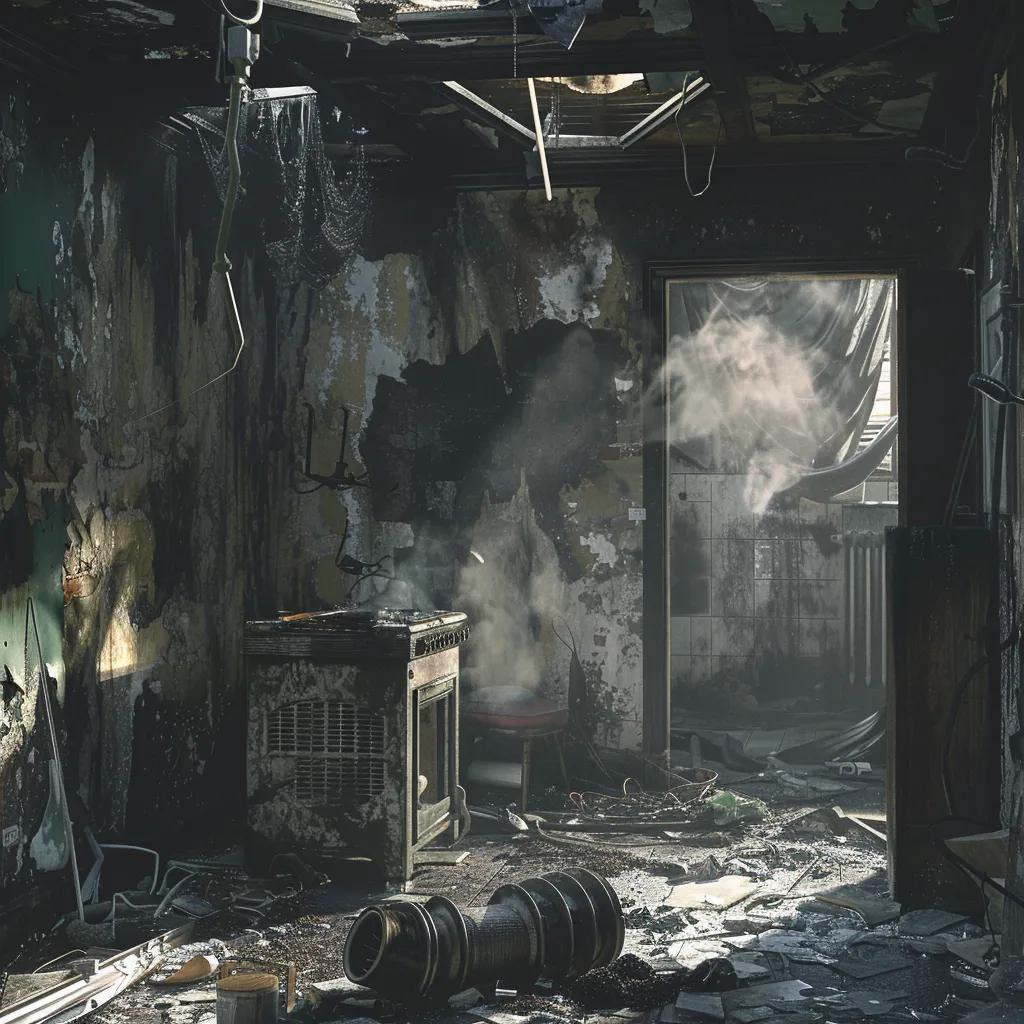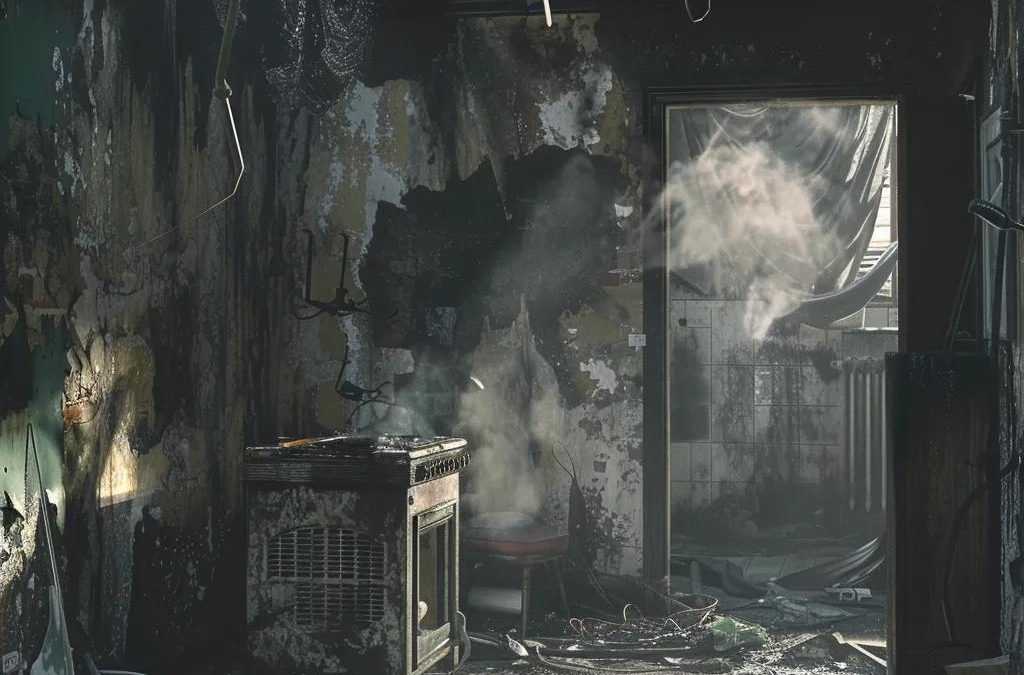
Puff Back Damage vs. Regular Fire Damage: Key Differences and Assessment for Property Owners

Did you know that a single furnace misfire can scatter oily soot across your home without a visible flame? Accurate puff back damage assessment is crucial for New York property owners to identify HVAC‐related explosions, avoid structural deterioration, and streamline insurance claims. In this guide, you’ll discover what causes puff backs, how regular fire damage differs, key soot characteristics, structural impacts, insurance nuances, prevention strategies, and when to call Restoration Experts for 24/7 emergency response, IICRC-certified procedures, and insurance claim assistance.
What Is Puff Back Damage and How Does It Occur?
Puff back damage occurs when an oil or gas burner experiences delayed ignition, leading to a sudden explosion in the combustion chamber that propels smoky, oily soot through HVAC ducts and living areas. This malfunction often results from clogged nozzles, fuel buildup, or ignition timing failures, depositing fine, greasy residue on walls, ceilings, and contents. For example, a furnace that misfires after a pilot light outage can coat ductwork with black “soot webs” and leave a petroleum-like odor in rooms, signaling the need for specialized cleanup.
What Causes Furnace Puff Backs?
- Clogged nozzles that disrupt fuel spray patterns and delay ignition
- Fuel system leaks or blockages leading to excess oil accumulation
- Faulty ignition timing or power interruptions in oil burners
- Inadequate maintenance that allows carbon buildup in the combustion chamber
Regular inspections and nozzle cleanings prevent these issues by ensuring proper fuel delivery and ignition timing.
What Are the Characteristics of Puff Back Soot?

- Oily, greasy texture that adheres stubbornly to surfaces
- Fine particulate size forming web-like patterns in ducts
- Distinct fuel or petroleum odor indicating oil burner origin
- Dark brown to black residue requiring chemical emulsifiers for removal
These traits differentiate it from dry, powdery soot produced by open-flame fires.
National Fire Protection Association, Fire Protection Handbook (2017)
Which Areas Are Commonly Affected by Puff Back Damage?
- HVAC ductwork and air registers
- Walls, ceilings, moldings, and baseboards
- Personal contents such as electronics, fabrics, and artwork
- Insulation cavities and hidden spaces behind walls
Mapping affected zones early guides Restoration Experts’ precision cleaning and deodorization plan.
What Defines Regular Fire Damage and Its Common Causes?
Regular fire damage results from open flames, intense heat, and smoke generated by combustion events, leading to charred structures, powdery soot, and strong burnt odors. Electrical faults, cooking accidents, or structural ignition can trigger these fires, causing widespread destruction that often requires comprehensive rebuilding rather than targeted soot removal.
Institute of Inspection, Cleaning and Restoration Certification (IICRC), S700 Standard for Professional Fire and Smoke Damage Restoration (2018)
What Are Typical Causes of Residential and Commercial Fires?
- Faulty wiring or overloaded electrical circuits
- Unattended cooking or grease fires
- Malfunctioning heating equipment unrelated to fuel misfires
- Combustible material ignition in garages or storage areas
Identifying the fire origin helps determine restoration scope and safety measures.
How Does Fire Soot and Residue Differ from Puff Back Soot?
- Dry, powdery particles that brush away easily
- Charring and blistering on structural materials
- Sharp, acrid burnt odor from combustion of diverse materials
- Soot layers often mixed with ash and debris
These characteristics contrast with the greasy, adhesive soot from furnace puff backs and guide restoration methods accordingly.
What Areas Are Usually Impacted by Fire Damage?
- Structural elements like beams, drywall, and floor joists
- Contents throughout rooms in direct flame or smoke path
- HVAC vents and duct interiors carrying smoke residues
- Surrounding areas beyond origin point due to smoke migration
Comprehensive assessment ensures removal of hidden residues and structural repair.
What Are the Key Differences Between Puff Back Damage and Regular Fire Damage?
Below is a detailed comparison of core attributes for puff back damage versus regular fire damage to support precise restoration planning and insurance claims.
| Feature | Puff Back Damage | Regular Fire Damage |
|---|---|---|
| Cause | Delayed furnace ignition or nozzle clog | Direct combustion from flame events |
| Soot Type | Oily, greasy particulate | Dry, powdery ash |
| Odor | Fuel/oil scent | Burnt, acrid smoke smell |
| Spread Pattern | HVAC system distribution | Flame and smoke path through open spaces |
| Structural Impact | Surface discoloration, minimal charring | Charring, structural weakening, widespread ash |
| Cleanup Complexity | Specialized chemical emulsification, duct cleaning | Comprehensive debris removal, rebuild sections |
| Insurance Coverage Nuances | Covered if mechanical failure, excludes negligence | Typically covered as fire event |
Why Is Understanding These Differences Important for Restoration and Insurance?
Properly distinguishing between puff back and fire damage ensures accurate restoration estimates and maximizes insurance reimbursements while avoiding denials due to misclassification.
How Does Accurate Damage Assessment Affect Restoration?
A professional damage assessment identifies the exact soot composition and spread, enabling technicians to select appropriate cleaning agents and restoration methods that prevent cross-contamination and reduce project time.
How Are Restoration Methods Tailored to Each Damage Type?
Restoration Experts applies:
- Puff Back Cleanup: targeted duct cleaning, wipe tests, and enzymatic deodorization
- Fire Damage Restoration: structural repairs, smoke odor removal, content pack-out and restoration
Each method aligns with industry standards like IICRC S700 to restore properties safely.
How Can Proper Documentation Facilitate Insurance Claims?
Detailed reports with photographic evidence, soot analysis, and scope of work help insurance adjusters validate claims for both puff back and fire damage, often resulting in full coverage and minimal out-of-pocket expenses for clients.
How Can Property Owners Prevent Furnace Puff Backs?
Routine maintenance and early detection are key to reducing the risk of furnace explosions and oily soot dispersal.
What Maintenance Practices Reduce Puff Back Risks?
- Annual oil burner and furnace inspections by certified technicians
- Nozzle cleanings and fuel filter replacements
- Combustion chamber tune-ups and gasket checks
- Duct seal inspections to prevent backflow of soot
Proactive upkeep keeps ignition timing precise and fuel delivery consistent.
What Are the Warning Signs of an Imminent Puff Back?
- Unusual fuel or oil odors near the furnace
- Black spotting or greasy buildup around vents
- Flickering pilot light or delayed burner ignition
- Strange noises such as popping or small explosions in the combustion area
Detecting these indicators early can prompt a service call before soot invades living spaces.
When Should You Call Restoration Experts for Puff Back or Fire Damage?
Immediate response limits damage spread and health hazards, and our locally owned team in Long Island and NYC is ready around the clock.
What Emergency Services Are Available for Puff Back and Fire Damage?
- 24/7 on-site assessment and board-up services
- Rapid soot containment and duct cleaning for puff backs
- Secure debris removal and structural stabilization after fires
Early intervention prevents secondary damages like mold and corrosion.
How Does Restoration Experts Follow Industry Standards?
All projects adhere to IICRC S700 procedures and ANSI guidelines, ensuring safe, certified restoration practices that meet insurance and building code requirements.
How Does Restoration Experts Assist with Insurance Claims?
Our staff handles billing and documentation, works directly with adjusters, and often secures claim approvals that result in no out-of-pocket costs for homeowners when policy terms are met.
What Are the Health Risks Associated with Puff Back and Fire Soot?
Exposure to soot and smoke residues poses respiratory and long-term health threats that require professional remediation.
How Does Puff Back Soot Affect Indoor Air Quality?
Oily soot contains fine hydrocarbons that:
- Adhere to HVAC coils and recirculate toxins
- Irritate respiratory linings and exacerbate asthma
- Deposit carcinogenic particles on surfaces
Removing this contamination preserves air quality and occupant health.
What Are the Health Implications of Fire Smoke and Soot Exposure?
Fire residues include:
- Irritant gases (e.g., acrolein, formaldehyde) that inflame airways
- Carbonaceous particles that deepen lung penetration
- Persistent odors that trigger headaches and dizziness
Comprehensive smoke odor removal and HEPA-filtered cleaning mitigate these risks.
How Do Puff Back and Fire Damage Restoration Processes Differ?
When it comes to restoration following a fire incident, understanding the differences between puff back and conventional fire damage processes is crucial for property owners. Puff back refers specifically to a situation where an explosion occurs within a furnace or boiler, causing soot and smoke to be expelled throughout the property. This phenomenon is typically the result of malfunctioning equipment, such as a dirty burner or a backdraft, which leads to an accumulation of flammable gases. In contrast, general fire damage restoration deals with the aftermath of an open flame affecting surfaces, materials, and structural components of a building. Both scenarios require specialized cleaning and repair, but the nature and extent of the damage can vary considerably.
The restoration processes differ significantly in their approach and techniques. With puff back damage, the focus is primarily on soot removal and air quality restoration, as affected areas are often cloaked in thick residue that can infiltrate walls, ducts, and furnishings. Technicians use specialized equipment and products to thoroughly clean surfaces and eliminate potential health hazards associated with inhaling soot particles. In contrast, fire damage restoration typically encompasses broader structural repairs, necessitating extensive fire debris removal, smoke odor elimination, and, in many cases, rebuilding elements that may have been compromised by flames. Each process demands a tailored strategy to effectively restore the property and ensure the safety of its occupants, reflecting the complexity of fire-related incidents.
Understanding each workflow streamlines recovery and enhances safety for building occupants.
What Are the Steps in Puff Back Soot Cleanup?
- Containment of HVAC system and affected zones
- Dry vacuuming and chemical wipe tests to identify soot concentration
- Chemical emulsification and steam cleaning of surfaces
- Duct sealing, negative-air scrubbing, and deodorization
Specialized equipment and emulsifiers restore homes to pre-damage condition.
What Does Fire Damage Restoration Involve?

- Safety inspection and structural stabilization
- Debris removal, soot blasting, and smoke residue cleaning
- Odor elimination using thermal fogging or ozone treatments
- Content pack-out, cleaning, and rebuilding of damaged materials
Comprehensive services return structures and belongings to safe, livable conditions.
What Should New York Property Owners Know About Insurance Coverage for Puff Back and Fire Damage?
When it comes to protecting their investments, New York property owners need to be particularly vigilant about the nuances of insurance coverage, especially concerning puff backs and fire damage. A puff back is a phenomenon that occurs when a furnace malfunctions, causing a backdraft that pushes smoke and soot into a home’s interior. This event not only leads to significant cleaning costs but can also result in structural damage if not addressed promptly. Property owners should understand that standard homeowners’ insurance policies may not always cover the extensive damages caused by puff backs. Therefore, it is advisable to review their insurance policies carefully and consider additional endorsements or specialized coverage that encompasses soot damage, particularly for older homes with outdated heating systems.
In addition to puff backs, fire damage is another critical area that property owners in New York must understand regarding insurance coverage. Fire-related incidents can be catastrophic, leading to not only property loss but also displacement of residents. Most standard homeowners’ insurance policies cover fire damage; however, it’s important for property owners to be aware of their limits, deductibles, and any exclusions that may apply. For example, certain types of fire-related damages stemming from negligence may not be covered. To avoid potential gaps in coverage, property owners should engage with their insurance agents to discuss their specific needs, assess the overall risks associated with their properties, and ensure that they have comprehensive insurance that adequately protects against both puff back incidents and fire damage. Staying informed and proactive can save property owners significant time and expense in the long run.
Is Puff Back Damage Typically Covered by Homeowners Insurance?
Most homeowner policies cover puff back damage if it results from a sudden mechanical malfunction rather than lack of maintenance.
- Exclusions may apply for neglect or overdue equipment servicing.
- Proper maintenance records strengthen coverage claims.
How Does Fire Damage Insurance Coverage Work?
Standard policies cover direct fire losses, including structural, content, and smoke cleanup costs.
- Coverage limits vary by policy and dwelling type.
- Additional living expenses may be reimbursed during repairs.
How Can Restoration Experts Help Navigate Insurance Claims?
Our insurance specialists prepare itemized estimates, coordinate with adjusters, and guide clients through policy terms, maximizing claim payouts and minimizing delays. Professional restoration and precise documentation ensure full alignment with insurer requirements. With a clear grasp of how puff back damage and regular fire damage differ, New York property owners can secure more accurate restoration estimates and optimize insurance recoveries. Restoration Experts stands ready to deliver prompt, IICRC-certified cleanup for both oily furnace explosions and full-scale fire events, backed by 24/7 emergency support and comprehensive claims assistance. Rely on our experienced team to restore your Long Island or NYC property to its pre-damage condition with minimal disruption.
Frequently Asked Questions
Q- What are the long-term effects of puff back damage on property?
A- Puff back damage can lead to significant long-term effects if not addressed promptly. The oily soot can corrode HVAC components, leading to costly repairs or replacements. Additionally, the residue can promote mold growth in hidden areas, compromising indoor air quality and potentially causing health issues for occupants. Over time, untreated puff back damage may also result in structural deterioration, requiring extensive restoration efforts. Regular maintenance and timely remediation are essential to mitigate these risks and preserve property value.
Q- How can I identify puff back damage in my home?
A- Identifying puff back damage involves looking for specific signs. Common indicators include unusual fuel or oil odors, black streaks or greasy spots around vents, and soot accumulation on walls and ceilings. You may also notice a flickering pilot light or delayed ignition of the furnace. If you observe any of these symptoms, it’s crucial to contact a professional for a thorough inspection and assessment. Early detection can prevent further damage and ensure effective remediation.
Q- What should I do immediately after discovering puff back damage?
A- Upon discovering puff back damage, the first step is to turn off the furnace and avoid using the HVAC system to prevent further soot spread. Document the damage with photographs for insurance purposes, and then contact a professional restoration service. They can assess the extent of the damage and recommend appropriate cleanup methods. It’s essential to act quickly to minimize health risks and property damage, as oily soot can be challenging to remove if left untreated.
Q- Are there specific cleaning products recommended for puff back soot?
A- Yes, specialized cleaning products are recommended for effectively removing puff back soot. Chemical emulsifiers designed to break down oily residues are essential for cleaning surfaces affected by puff back damage. Additionally, using HEPA-filtered vacuums can help capture fine soot particles without redistributing them into the air. It’s advisable to consult with restoration professionals who can provide the right products and techniques tailored to your specific situation, ensuring thorough and safe cleanup.
Q- How can I prevent puff back damage in the future?
A- Preventing puff back damage involves regular maintenance and inspections of your heating system. Schedule annual check-ups with certified technicians to ensure proper functioning of oil burners and furnaces. Regularly clean nozzles and replace fuel filters to prevent clogs. Additionally, monitor for signs of fuel leaks or unusual odors, and address any issues immediately. Implementing these proactive measures can significantly reduce the risk of puff back incidents and maintain the efficiency of your heating system.
Q- What are the differences in insurance claims for puff back versus fire damage?
A- Insurance claims for puff back damage typically hinge on whether the incident resulted from a sudden mechanical failure, which is generally covered, versus negligence or lack of maintenance, which may not be. In contrast, fire damage claims usually cover direct losses from flames and smoke, with fewer exclusions. Understanding these distinctions is crucial for property owners to navigate their policies effectively and ensure they receive appropriate compensation for the type of damage incurred.
